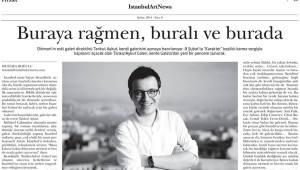
Cultural Studies 2008 graduate Tankut Aykut opened his personal gallery with an exhibition called "Characters."
Tankut Aykut Gallery was inaugurated with a joint exhibition titled "Characters" with curator Elif Gül Tirben (VAVCD 2009 graduate).
When does character manifest itself; is it hidden in habits, or in reactions to extraordinary events? Is the body a surface that reflects character, or does the body have a character of its own? Does our language reflect our character? Is character fate? What do we mean when we talk about the character of a society, government or forest?
Character derives from the Ancient Greek "kharassein," meaning to brand, engrave or carve, and was first used to refer to "branding iron," "stamp," "mark" or "sign." In time, the word gained concrete referents like "symbol," "letter" or "typeface," and then started to bear symbolic meanings like "the whole of differentiating, defining properties," "an entity that is part of a narrative" and "an individual with extraordinary attributes."
What makes character observable as a brand or mark is its manifestation through repetitive actions and conduct, and the comparison with the action and conduct of others. The exhibition is a thought practice on characters - unique personal patterns that gain visibility against the backdrop of society.
Sevgi Aka has two books in the exhibition: 15.11.11 and 13.3.13, which contain the alphabetical list of all words used by the artists on those two dates, in two different geographical locations and languages. The choice of words by the artist, who becomes a part of different systems by speaking in different languages, is an opportunity for witnessing the fluidity of character through the subjectivity and anonymity of language.
Bora Başkan discusses the determining aspects of time and place in Track I and II, composed of moments picked from the daily lives of white collar workers. According to Başkan, "The character of an individual desires to be perceived as a whole. But while character tries to maintain its singularity, place slips from under one's foot. Time, then, becomes a track that surrounds the character."
"Evil Co." is a "business" by Fatma Belkıs and Onur Gökmen, where they re-produce their artistic roles deriving from the similarities between business production and artistic production. "Company of Noses of Companies" is a project that the artists have been working on since they founded Evil Co. in 2012. According to the artists, the owners of the noses that were shipped abroad by Evil Co. in an attempt in tax fraud "describe an entrepreneur who wishes to make a mark on their business."
Murat Durusoy’s "Portraits for Remembrance" consists of televised images of the main characters involved in the most impactful social events in near history. Manipulated ethereal images recall nightmarish visions of traumatic social events while depicting the character of the society we live in.
Merve Ertufan's Sketch questions reliability of our processes for understanding and evaluating individuals. The artist asks illustrator Gökhan Okur to make an illustration of her. A recording of the sketching session reveals the consequences of prolonged exposure to the roles of subject and object or observer and observed. With unexpected comments like "your face is so fluid, all the lines are melting into each other," the recording provides the dynamics of perceiving and recording in daily life, which are momentary and therefore immediately forgotten.
Sibel Horada's Fill in the Blanks eliminates four main female characters from four famous paintings to also remove them from the gaze of the viewer. Paintings are multiplied in postcard format, and compel us to think on the representations in the image through a simple gesture.
Based on Schopenhauer’s idea that “within everything, man perceives himself above all," Reysi Kamhi defines character as a state of conviction. The artist picks images from her Temporality and Vanitas series to express her character through the transitions between natural objects and forms, like crystals and stones, which take thousands of years to achieve the form to which they are imprisoned, and abstract depictions of the sky.
The main inspiration for this exhibition is Komet's assemblage titled Being a Bird. The absurd character, formed of three ready-made objects and a bunch of strings, is an understatement of all that we have to say but cannot as the world we live in becomes more and more absurd.
In the series *, Aslı Narin takes pictures of spots on her skin and matches them to a celestial map. As the number of spots grow, they shape the body like the alignment of celestial objects shapes the character.
Elif Süsler’s video collage Candid consists of short pauses where the presenters or guests of TV talk shows, reality shows and similar programs take a breath. The artist looks for a candid or genuine act in these persons in order to establish a relationship with them. According to Süsler, "short pauses for breath and random exclamations are the most genuine among the throng of words and expressions repeated."
The forest as a leitmotif and projection of the mental landscape of artist Tuba Yalçınkaya transforms into a threatening living space that reflects the character of the country in Forest II. Trees decorated with pennants that stay erect in the face of the massive whirlpool in the forest floor give us ideas about the character of the forest.
We wish our alumnus a successful life.
Alumni Relations Office
02164839352
alumni@sabanciuniv.edu

